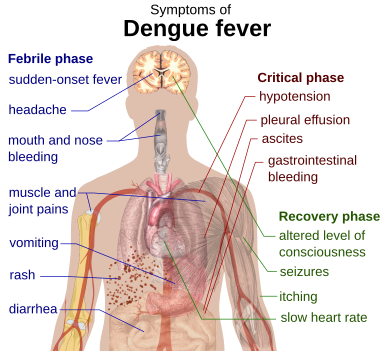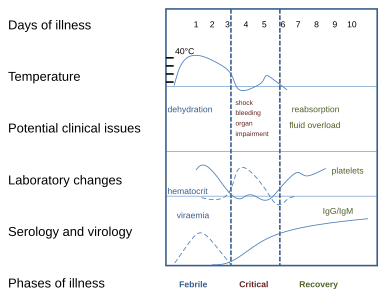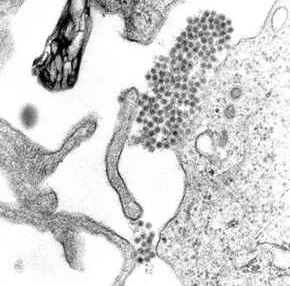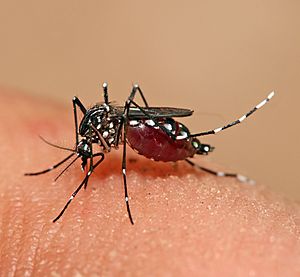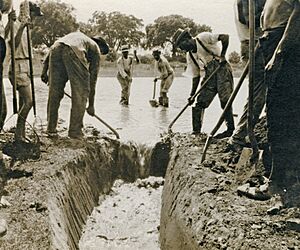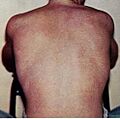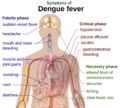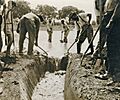Dengue facts for kids
Quick facts for kids Dengue fever |
|
|---|---|
| Synonyms | Dengue, breakbone fever |
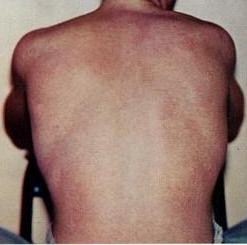 |
|
| The typical rash seen in dengue fever | |
| Symptoms | Fever, headache, muscle and joint pain, rash |
| Complications | Bleeding, low levels of blood platelets, dangerously low blood pressure |
| Usual onset | 3–14 days after exposure |
| Duration | 2–7 days |
| Causes | Dengue virus by Aedes mosquitos |
| Diagnostic method | Detecting antibodies to the virus or its RNA |
| Similar conditions | Malaria, yellow fever, viral hepatitis, leptospirosis |
| Prevention | Dengue fever vaccine, decreasing mosquito exposure |
| Treatment | Supportive care, intravenous fluids, blood transfusions |
| Frequency | 390 million per year |
| Deaths | ~40,000 (2017) |
Dengue fever is a sickness you can get from mosquito bites. It's caused by the dengue virus and is common in warm, tropical places.
Usually, symptoms start about 3 to 14 days after a mosquito bites you. You might get a high fever, headache, feel like throwing up, have muscle and joint pains, and a special skin rash. Most people feel better in about 2 to 7 days.
For a few people, dengue can become very serious. This is called severe dengue. It can cause bleeding, very low levels of blood parts called platelets, or dangerously low blood pressure.
Dengue is spread by several kinds of female Aedes mosquitoes, especially Aedes aegypti. There are five types of the dengue virus. If you get infected with one type, you usually become immune to that specific type for life. But you only have short-term protection against the other types. If you get infected with a different type later, you might get sicker.
There are ways to find out if you have dengue, like checking for parts of the virus or special antibodies in your blood. Two vaccines are available to help prevent it. Another way to prevent dengue is to get rid of places where mosquitoes live and to avoid getting bitten. This means removing or covering standing water and wearing clothes that cover your skin.
If you have dengue, doctors will help you feel better with "supportive care." This often means drinking lots of fluids or getting fluids through an IV. For very serious cases, some people might need blood transfusions. Doctors usually recommend Paracetamol for fever and pain, instead of other pain medicines, because some medicines can increase the risk of bleeding.
Dengue has been around for a long time, with the first reports from 1779. It became a bigger problem around the time of World War II and is now common in over 120 countries, especially in Southeast Asia, South Asia, and South America. About 390 million people get infected each year.
Contents
What are the signs of dengue?
Most people (about 80%) who get the dengue virus don't have any symptoms or only feel a little sick with a mild fever. Others (about 5%) get sicker, and for a small number, it can be life-threatening.
The time from when you get bitten by an infected mosquito to when you start feeling sick is usually 4 to 7 days. It can range from 3 to 14 days. So, if you've traveled to a place where dengue is common and you don't feel sick for more than 14 days after coming home, you probably don't have dengue.
Younger children often have symptoms that seem like a common cold or a stomach bug (like throwing up and diarrhea). They are more likely to have serious problems, even if their first symptoms are mild.
How do you get dengue?
The dengue virus is mainly spread by Aedes mosquitoes, especially Aedes aegypti. These mosquitoes usually live in areas between 35° North and 35° South of the equator, below 1,000 meters (about 3,300 feet) in height. They often bite in the early morning and evening, but they can bite at any time of day.
Other Aedes mosquitoes that can spread the disease include A. albopictus, A. polynesiensis, and A. scutellaris. Humans are the main carriers of the virus, but it can also be found in some monkeys. You can get infected from just one mosquito bite.
When a female mosquito bites a person who has dengue fever, it picks up the virus. After about 8 to 10 days, the virus moves to the mosquito's salivary glands. Then, when the mosquito bites another person, it can pass the virus into their body through its saliva. The virus doesn't seem to harm the mosquito, and the mosquito stays infected for its whole life.
Aedes aegypti mosquitoes are especially good at spreading dengue because they like to lay their eggs in man-made water containers, live close to people, and prefer to bite humans.
Dengue can also be spread through infected blood products or organ donation, but this is much less common.
When an infected mosquito bites you, the virus enters your skin with the mosquito's saliva. It then enters your white blood cells and makes more copies of itself as these cells move around your body. Your white blood cells react by making special proteins that cause many of the symptoms, like fever, flu-like feelings, and severe pains. In serious infections, the virus grows a lot, and more parts of your body, like your liver and bone marrow, can be affected.
How do doctors diagnose dengue?
|
Warning signs
|
||||
| Worsening stomach pain | ||||
| Throwing up a lot | ||||
| Liver gets bigger | ||||
| Bleeding from gums or nose | ||||
| High blood count with low platelets | ||||
| Feeling very sleepy or restless | ||||
| Fluid buildup in body cavities | ||||
Doctors usually figure out if someone has dengue by looking at their symptoms and doing a physical examination. They might also do blood tests to confirm it.
How can you prevent dengue?
Preventing dengue means controlling the mosquitoes that spread it and protecting yourself from their bites. The World Health Organization suggests a plan with five main parts:
- Getting people and communities involved to help public health groups.
- Working together with different groups, both public and private.
- Using a combined approach to control the disease and use resources well.
- Making decisions based on facts to make sure actions are helpful.
- Building up skills to respond to the situation in each area.
The best way to control A. aegypti mosquitoes is to get rid of their homes. This means removing open sources of water where they lay eggs. If water can't be removed, people can add special bug killers (insecticides) or natural agents to these areas. Spraying bug killers everywhere is sometimes done, but it's not thought to be very effective. Changing the environment to reduce standing water is the best method.
You can prevent mosquito bites by:
- Wearing clothes that cover your skin fully.
- Using mosquito nets when you are resting.
- Putting on insect repellent (like DEET, which is very effective).
While these steps can help you avoid getting bitten, they don't stop outbreaks from happening. Outbreaks seem to be increasing in some areas, possibly because cities are growing, which creates more places for A. aegypti mosquitoes to live. The areas where dengue is found might also be growing because of climate change.
International Anti-Dengue Day
International Anti-Dengue Day is celebrated every year on June 15. This idea started in 2010, and the first event was held in Jakarta, Indonesia, in 2011. The goals are to teach people more about dengue, gather help for preventing and controlling it, and show that countries in Southeast Asia are serious about fighting the disease.
How is dengue treated?
There are no specific medicines that kill the dengue virus. However, it's very important to keep your body properly hydrated (have enough fluids). Treatment depends on your symptoms.
If you can drink fluids, are peeing normally, don't have any "warning signs" (see the table above), and are otherwise healthy, you can usually be cared for at home. You'll need to drink plenty of fluids and have daily check-ups with a doctor.
If you have other health problems, show "warning signs," or can't get regular check-ups, you should be cared for in a hospital. For very serious cases of dengue, care should be given in a place with an intensive care unit.
What is the outlook for people with dengue?
Most people with dengue get better without any lasting problems. For those with severe dengue, the risk of death is usually low, about 0.8% to 2.5%. With good medical care, this risk is less than 1%. However, if blood pressure drops very low, the death rate can be higher, up to 26%.
The risk of death for children under five years old is four times higher than for those over 10. Older people also have a higher risk of a poor outcome.
History of dengue
The first possible record of dengue fever is from a Chinese medical book written between 266 and 420 AD. It talked about a "water poison" linked to flying insects. The main mosquito that spreads dengue, A. aegypti, spread out of Africa between the 15th and 19th centuries, partly because of more global trade, including the slave trade.
There were reports of outbreaks in the 17th century, but the clearest early reports of dengue outbreaks are from 1779 and 1780. During these years, an epidemic spread across Southeast Asia, Africa, and North America. From that time until 1940, big outbreaks were not very common.
In 1906, scientists confirmed that Aedes mosquitoes spread the disease. In 1907, dengue was the second disease (after yellow fever) found to be caused by a virus. More research by John Burton Cleland and Joseph Franklin Siler helped us understand how dengue spreads.
The big spread of dengue during and after World War II is thought to be because of big changes in the environment. These changes also led to different types of the disease spreading to new areas and the rise of severe dengue. This serious form was first reported in the Philippines in 1953. By the 1970s, it was a major cause of child deaths and had appeared in the Pacific and the Americas.
What does "dengue" mean?
The word "dengue" came into English in the early 1800s from Spanish spoken in the West Indies. The Spanish word came from the Kiswahili term dinga (short for kidingapopo), which means "disease caused by an evil spirit." The term "dengue fever" became commonly used after 1828.
New treatments
Besides trying to control the spread of the Aedes mosquito, scientists are working to create antiviral medicines that could treat dengue fever and stop serious problems. Knowing the structure of the virus's proteins can help in making these effective drugs.
Some studies have looked at Carica papaya leaf extract for treatment. As of 2020, studies have shown it can help with some blood test results, but it's not yet proven to help with how the disease turns out. So, it's not a standard treatment.
In October 2021, a university in Belgium announced they had developed an antiviral medicine with Janssen Pharmaceutica that might also help prevent the disease.
Images for kids
-
A TEM micrograph showing dengue virus virions (the cluster of dark dots near the center)
See also
 In Spanish: Dengue para niños
In Spanish: Dengue para niños


